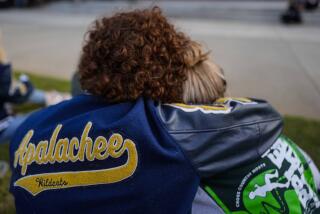Experiment at School Explodes, Burns 3 Students
A cannon made from apple juice cans exploded in a fireball during a high school science experiment in Newhall on Wednesday, burning three students, one of them critically.
The experiment, in which flaming alcohol was intended to launch a tennis ball as a projectile, was conducted on the football field of Hart High School under the supervision of a science teacher, school officials and sheriff’s deputies said.
However, one student said the teacher was not closely attending the test that went awry, and some other science teachers expressed surprise at the experiment.
“I don’t know what they were trying to prove,” said Sidney Benson, a retired USC chemistry professor. “It sounds a little strange to me.”
Although it is not yet clear exactly what happened, experts say that the accident may have stemmed from the fact that alcohol burns with a flame that is almost invisible in sunlight. They said the students may have poured more alcohol onto fuel that was already burning, causing the explosion.
Christopher James, 17, one of the school’s top soccer players, suffered third-degree burns over 35% of his body, including his hands, arms, chest, shoulders and face, officials said.
The most serious injuries were to his larynx and lungs, which were seared when he inhaled superheated air from the explosion, according to Dr. A. Richard Grossman, director of the Grossman Burn Center at Sherman Oaks Hospital, where Christopher was taken. Grossman said the injuries were potentially life-threatening.
Nolan Lemar, 17, a third baseman on the school’s baseball team, was reported in fair condition at the burn center Wednesday night with second- and third-degree burns over 12% of his body, said Larry Weinberg, a burn center spokesman. The explosion seared the left side of Nolan’s upper body including his ear, scalp, face, nose, neck, chest, forearm and hand, Weinberg said.
A third student was treated for lesser injuries at Henry Mayo Newhall Memorial Hospital in Newhall and released, according to a hospital spokesman, who declined to identify the youth.
Hart Union School District Supt. Robert Lee said about 35 students and their physics teacher, identified by sheriff’s deputies as Thomas Magee, had gathered on the football field about 8:30 a.m. to conduct the experiment.
“The class had done the experiment two to three times that morning,” Lee said. “It’s a common physics experiment. . . . This was an experiment that was done last year.”
The students had made the cannon by soldering a 16-ounce apple juice can, from which the top and bottom had been removed, atop a 12-ounce can, said Lt. Tom Spencer of the Sheriff Department’s arson squad.
Methanol poured into the top can dribbled into the smaller can on the bottom, and a tennis ball was placed in the top can as a projectile, Lee said. A match applied to the device was supposed to detonate the methanol, launching the tennis ball, he said.
Students said that when Magee tried to conduct the first experiment of the day, the tennis ball failed to leave the cannon.
According to junior Nick Langer, Magee handed a gallon container of methanol and a pack of matches to the students. Students fired off a few volleys with the launcher, but the balls still did not travel very far.
“The students added more methanol--it didn’t work,” Langer said. “They added even more fuel, that didn’t work.”
Another student, Billy Dillenberger, said Magee split the students into two groups on the football field. Magee went with one group, leaving Dillenberger’s group to continue on its own.
“The kids were starting to horse around,” Dillenberger said. “Kids started putting in way too much [alcohol]. That’s when I started to walk away, because this stuff is explosive. I knew that it wasn’t good.”
Suddenly, a fireball erupted behind him, Langer said.
“Chris was running around, rubbing his face, and then he just fell on the ground,” Langer said.
As Christopher writhed on the ground, another student used a fire extinguisher to put out the flames that engulfed him.
Because the alcohol flames were so hard to see, it took fellow students a few seconds to realize that Nolan was on fire, too.
“Me and another kid threw him on the ground and helped him to roll around and get his clothes off,” Dillenberger said.
Dillenberger said he did not blame the teacher.
“He didn’t realize what they were doing. . . . He was roaming back and forth between the two groups.”
Dillenberger’s mother, Denise Dillenberger, agreed.
“I think it was an experiment that just didn’t go off right,” she said. “I’m not upset at the school. I’m not upset with the teacher. It’s a tragedy.”
Sandor Reichman, a chemistry professor at Cal State Northridge, questioned the use of burning alcohol, saying that the liquid’s clear, almost invisible flame might have led students to add more alcohol to the cannon without realizing they were pouring fuel onto a live flame.
Another instructor said it may have been fortunate that the incident took place outdoors.
It would be easier to see the flame inside, said USC chemistry professor Robert Beaudet. “But outside, [the methanol] would disperse more. If this would have happened inside, you would have had the whole building on fire.”
Grossman said the burn center would try to stabilize Christopher’s condition over the next 48 hours, placing him in a hyperbaric oxygen chamber.
“On Friday or Saturday, will we get surgery started to revitalize the tissue,” Grossman said, using skin transplants from Christopher’s thighs, calves and scalp.
“The skin from the scalp is the best color match,” Grossman said. “We have to think about cosmetics because he is a 17-year-old man.”
More to Read
Sign up for Essential California
The most important California stories and recommendations in your inbox every morning.
You may occasionally receive promotional content from the Los Angeles Times.










